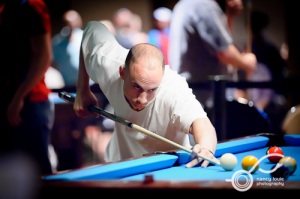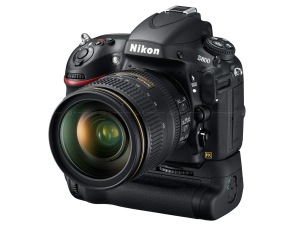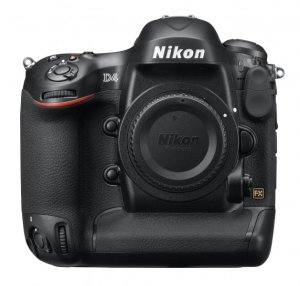July 7, 2012 by Nancy Louie
 It was my ultimate pleasure to be able to photograph pool players in action last weekend. Atlantic City, NJ was the host location for the APA South Jersey annual LTC (Cities) tournament. This is the qualifier for teams to play in the nationals in Las Vegas.
It was my ultimate pleasure to be able to photograph pool players in action last weekend. Atlantic City, NJ was the host location for the APA South Jersey annual LTC (Cities) tournament. This is the qualifier for teams to play in the nationals in Las Vegas.
However, I am also a player so it was difficult to do both. Fatigue and concentration not withstanding. I needed to clone myself to be in more than one place at a time and grow another pair of arms.
As far as technique is concerned, you need to shoot with wide open aperture and without a flash. A flash would be very distracting in this situation. I also used a 70-200mm f/2.8 lens. Why? To remain unobtrusive to the player(s). A longer lens will allow you to photograph from a distance and not be in someone’s face. Most of the players had no idea that I had taken their image as they were playing. In using a longer lens, you would need to get your shutter speeds up or you might get camera shake and blurry images, so boost your ISO (the D700 is a low light champ for this) to get decent shutter speeds. Since the tournament area is pretty crowded, a wide open aperture lets more light in as well as blurring out some of the distracting background.
The tournament area was fairly dark, primarily lit by standard light fixtures over the tables. This is often a photographer’s worst nightmare when you can’t add in artificial light. I decided that I would use it to my advantage because the light cast was more dramatic and not flat. I needed to combine my field of view with timing so that what little light provided would enhance the look and feel. The only issue I encountered was when people wore a lot of white and were directly under a light. Lightroom post processing with the Recovery slider took care of most of it. I burned the rest where needed.
Tricky but in the end, it was worth it for images that pop. I’m not going to Vegas, but I did get my shots.
Posted in shoots | Tagged billiards, low light, photography, pool | 3 Comments »
May 25, 2012 by Nancy Louie
If you noticed some errant underexposed images when using your D700, it may not have been due to your settings. Nikon has released a firmware update that corrects the issue. The aberration for the severely underexposed images is rare but can occur.
It is not difficult to implement a firmware update to your camera’s inherent processing software. The instructions can be downloaded along with the update. You do need a card reader, but you should be using one anyway. It’s always wise to implement firmware updates from the manufacturer. In this case, I’m surprised that this fix hasn’t been offered sooner. The D700 has been out for almost 4 years!
Here’s the link: D700 Firmware Update
Posted in cameras, nikon, software | Tagged D700, firmware update, fix, nikon, software | 2 Comments »
April 24, 2012 by Nancy Louie
NAPP is launching their first Special training event with webcasts for a week on the Creative Suite 6.
CS6 Live
Looks like it’s free and live to the public for this week only. After this week, you’ll have to be a NAPP member and sign on to the NAPP website to view. Since I considered the CS 5.5 upgrade ho hum (I didn’t bother), I’m interested to see something substantial in the way of the upgrade to CS6. The Creative Suite is no drop in the bucket financially. I’d want to see Illustrator beefed up somehow. Acrobat Pro too. Photoshop was definitely punched up. InDesign adds liquid layouts so designers can repurpose content more easily. Dreamweaver has been boosted, but I don’t think I will be using some of their tools like the developers drool over. Adobe is pushing the envelope with their new Creative Cloud subscription service. Ouch, introductory pricing is $30. USD a month discounted for existing owners ? That’s $360 for a one-year plan. If you go month to month, it jacks up to $75.
Can Adobe improve upon their industry standard tools? Guess we’ll see.
Posted in software | Tagged creative suite, CS6, free, NAPP, Training, upgrade, webcast | Leave a Comment »
February 21, 2012 by Nancy Louie
Three and one-half years… but not quite four. Nikon had a few surprises up their sleeve after all. The D800/800E (no anti aliasing in the E version) is somewhat of the successor to the D700 but to me, it’s a beast of a different color. Nikon Rumors did predict that Nikon would fill the gap between 12.1 MP to 36.3 MP in one fell swoop. Does this guarantee that they will win the megapixel race in the pro circuit at a certain price point? I’m sure that is not the intended goal. At least not without a few tradeoffs. Plunk down your $3,000 if you’re the type who likes to be first. That’s still a good price considering what a D3X costs.
The fps is slower at 4 fps in FX, 6 fps in DX mode but the level of detail is OMG. Count eyelashes. I’m not so sure that the average Jane is going to want to put herself in front of the D800 without making sure her makeup is picture perfect. All flaws will be magnified. I also believe that the D800 will not take the crown for low light shooting from the D4 or from the D700 for that matter. ISO is 100-6400. This doesn’t seem to be the camera you grab to shoot candids. It seems that it’s more targeted to studio and wildlife shooting.

D800 with grip
What is nice is that the D800 encompasses the dual card slots feature found on many of the other Nikon predecessors. One CF card and one SD card.
1080/30p HD video is a D800 feature that was missing from the D700. This will pair up nicely with the better lenses. Video has been on all Canon bodies for a long time. Even most of the Nikon lineup after the D90 sported video. The D700 seemed lonely without it.
The buzz is still buzzing a couple of weeks later. Preorders have been stopped with the 3 year pent up demand. You can expect the first shipments mid- to end March. Make sure you also budget for more storage space since the output is three times the D700 resolution. That means more hard drives and perhaps more processing power if you don’t already possess it.
All in all, this is a beautiful camera body with some advanced features. I am positive that once it gets into the hands of those who preordered it that we will see what it can do in real use.
Posted in nikon | Tagged camera, D800, nikon, photography | Leave a Comment »
January 9, 2012 by Nancy Louie
I couldn’t allow the time to slip away without mentioning Nikon’s announcement of their new D4 body last week. It’s a beauty. Finally, a larger sensor format at 16.2 megapixels with tha t venerable high ISO performance in Nikon’s lineup.
t venerable high ISO performance in Nikon’s lineup.
Here’s the link to Nikon’s official press release on the bells and whistles. New sensor, new color matrix meter—may mean that Nikon is going to lay claim to being the low light champ with increased MP size at the top of the heap. Considering how difficult it is to a have larger capture size being noise free without making other sacrifices, I marvel at their efforts.
Some of the pundits were confused by the timing of the release, but I’m not. It makes perfect sense that Nikon would release this for pros in time for the Winter Olympics. I was concerned that the earthquake/tsunami in 2011 would really set back some of their FX body releases. This is a very positive sign that Nikon is not asleep with just repurposed goods like that “new” SB-910 speedlight.
This doesn’t mean that I’m ready to plop down $6,000 USD to order mine in advance (they should begin shipping in Feb.) It’s too large for my needs which is why I passed on the initial release of the D3 when it came out and was happy when the D700 popped a year later. What it does mean is that we can now all freely begin to speculate on an eventual D800 body release with greater certainty that Nikon has finally figured out how to break that 12MP noise ceiling for performance. I hope the lighted buttons feature filters down to the D800. It’s been 3 years and counting since the D700 release. What’s another year?
Posted in nikon | Tagged camera, D4, nikon, photography | Leave a Comment »
December 30, 2011 by Nancy Louie
The body speaks volumes in small nuances of positioning. I often will pose people standing as well as sitting. The skeleton provides the framework for the body. A sitting position will naturally bend limbs like arms and legs. A limb that is bent also provides visual interest since it is less static.
If you ask a person to sit, s/he feels like they are “doing something.” Yet this helps them relax. More often than not, a relaxed subject will allow you to “see” into their persona. This makes for a better portrait.
If there is a height disparity in subjects (2 people in the scene/frame) it often alleviates the difference when they are seated.
If you choose to show hands in your portrait (I often do since I feel that hands can help provide storytelling fodder about the subject) make sure you deliberately position them with care. A seated position naturally allows for positioning in a lap rather than dangling arms at the side.
Some people photograph better standing but make sure you try a seated position too. I think you’d be surprised at results. It goes without saying that if you are using studio lighting that you must adjust your lights, but it’s well worth your time to try a seated pose.
Posted in tips | Tagged people, photographing people, photography, posing, tips | 1 Comment »
November 16, 2011 by Nancy Louie
I daresay that this blog is not tech oriented, but since we are living in a tech surrounded world today I thought that I’d mention these gloves. The holiday season is right around the corner so people are beginning to shop for gifts.
So much is touch screen sensitive today so what happens if you live in an area where it gets cold enough to wear gloves? Gas station pumps, GPS units, mobile phones, compact digicams—even ATM machines are heavily reliant on human touch without interference. Who feels like removing gloves when you need that function?
Looks like Isotoner smarTouch Gloves might make the ideal holiday gift for someone on your list. Touch screen compatible! They have around for a while, but if you can’t afford to buy an expensive tech gift, you might be able to afford these to allow that tech-using person to function better in the cold weather.
Posted in new tech | Tagged devices, function, gloves, smarTouch, technology | 1 Comment »
October 31, 2011 by Nancy Louie
I’ve been waiting for a D700 successor for over three years. There are always rumors about the arrival of new camera bodies and what they are prepared to do for your photography. Take it to the next level? I don’t think that any equipment should bear that responsibility. It takes more than just gear acquisition to make a good photograph. Beyond the technical knowledge, there’s always the harder-to-be-taught subjects like composition and “intent” of the photo. But, hardware is hardware and it looks bleak for new releases at this time.
Nikon Rumors is such a popular site for speculation about what’s in the pipeline and its release date. There was heavy spec that Oct. 26, 2011 would bear the successor to the D700. Unfortunately, it’s rumor. The latest developments are being discussed over at Nikonians in good detail so drop in and read more about it.
Mother Nature has had a heavy hand in squelching Nikon’s manufacturing process. First the earthquake in Japan in March 2011 and now the Oct. flooding in Thailand. Both locations factor predominately in producing for Nikon. It will take months to recover the cogs in the wheel. Even if the bulk of manufacturing was not affected at both locations, there’s still the smaller components being made by 3rd parties in Thailand that have been hurt/disabled.
The best camera is the one that is in your hands at present. I am glad that my gear envy has been tempered through the years. Looks like my wait for a D800 is going to lengthen into 2012.
Posted in nikon | Tagged body, camera, equipment, gear, new, nikon, photography | Leave a Comment »
October 11, 2011 by Nancy Louie
Since Canon’s announcement of the newer PowerShot S100 compact camera on Sept.15, 2011, the Canon PowerShot S95 has dropped to $319. on Amazon. I’d check this deal out if you’re in the market for a super compact camera at a sweet price point. I do own the S95. The image quality is great for a compact P&S camera.
The S100 is a little wider at 24mm vs. 28mm (s95) but I won’t mince about the extra angle of view possible. However, it is also longer on the tele end, has new sensor technology that is supposed to be better in low light (with reduced noise) and it’s 12.1MP The S100 is supposed to release in November 2011. DPReview did do a preview of it in case you’re drooling. For most intents and purposes this is a new camera unlike the S95 that morphed out of the S90.
That said, if can live without the latest and greatest and save some $ there’s good deals out there on the S95 right now. You’ll save close to $80—$100.
Posted in Canon, Deals | Tagged camera, canon, compact, P&S, photography, S100 | Leave a Comment »
April 27, 2011 by Nancy Louie
The Lightroom 3.4 update was just released by Adobe. There’s also an update to Camera Raw (and DNG converter) to version 6.4.
The new Lightroom update includes support for several new camera bodies and corrections/fixes to 3.3. If you’re one to think “Well, I don’t need this because my camera model is already supported,” I would think again because some of the bugs fixed problems in the Publishing module. The Publish module had expanded to include publishing via direct export out of Lightroom to Flickr, SmugMug as well as Facebook.
If you were using a Nikon D7000 or Pentax K-5 with RAW capture and multi-exposure, there was a magenta color cast that was fixed. There’s a host of other bugs fixed so it may be worth your time to update. Everything isn’t user error generated.
Here’s the download link to both updates.
Posted in Lightroom | Tagged 3.4, 6.4, Lightroom, software, update | Leave a Comment »
Older Posts »
 It was my ultimate pleasure to be able to photograph pool players in action last weekend. Atlantic City, NJ was the host location for the APA South Jersey annual LTC (Cities) tournament. This is the qualifier for teams to play in the nationals in Las Vegas.
It was my ultimate pleasure to be able to photograph pool players in action last weekend. Atlantic City, NJ was the host location for the APA South Jersey annual LTC (Cities) tournament. This is the qualifier for teams to play in the nationals in Las Vegas.


